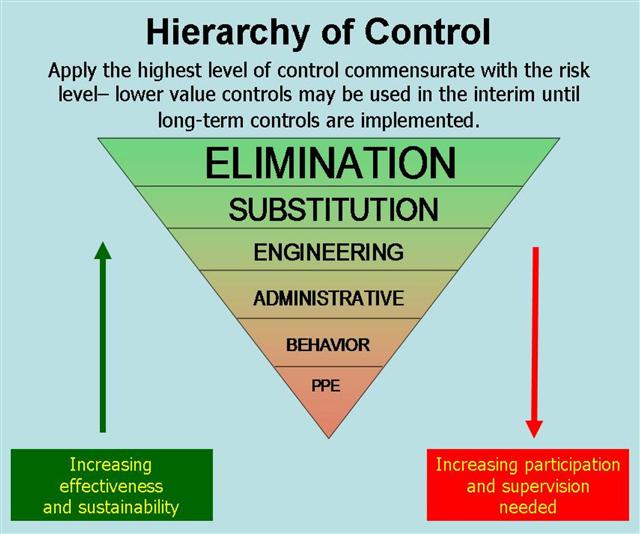The Hierarchy of Controls is a “system used in industry to minimize or eliminate exposure to hazards“.
Bicycle helmets come at the bottom, or least effective end of the pyramid, as they are “personal protective equipment”.
What would this diagram translate to if applied to safety for cyclists?
Elimination
How can we eliminate cars? Actually it’s already been done, in certain places. Think, pedestrian malls, off-road bike paths, parks and gardens. No deaths due to motor vehicles where they are eliminated. Expanding such areas is therefore the most effective way of improving safety for cyclists (and pedestrians). More car-free areas in our cities, for example. Banning cars from outside schools would help get more children walking and cycling to school.
Subsitution
More use of walking, cycling and public transport substitutes for car use. How is this achieved? By making these modes more attractive than driving a car.
Engineering
For bicycles, this covers physical separation, e.g. by a kerb or a barrier. Also underpasses or bridges that avoid crossing roads at grade. In other words, what we call “infrastructure”.
Administrative
For bicycles, this covers white lines painted on the road, speed limits, bicycle symbols painted on the road and all rules such as “a meter matters“.
Behaviour
Advertising campaigns and education efforts, such as those promoted by the Amy Gillett Foundation.
Personal Protective Equipment
The least effective measure. Helmets.
Thanks to @QAGreenways for permission to publish the graphic below:



Excellent write up – i had been meaning to do a post on this very approach.
Bicycle Helmet laws are out of step with Reality.
I support freedom of choice, but not all bike accidents involve cars. My head has fared better than my helmet after numerous off-road crashes.
@Tim Britten
Transport cycling is a different beast. You’re right, I would definitely ware a helmet on dirt/mountainous terrain. I would also ware a helmet if i were to ride in traffic at 30+ kph.
However, to ware a helmet on an upright, on a segregated track, with loads of other similar riders, below 30kph? I’m not so sure our standard helmet would do very much as far as providing higher levels of safety when compared to the other factors involved.
I too have trashed helmets and helped others fit them only to see them trashed… but did it do what we think? http://www.cyclehelmets.org/1209.html
I don’t believe that you understand the process of risk analysis. The elimination of risk in this case would have a number of issues to consider and certainly one of those would be impact from cars, however direct impact to the head or other part of the body should also be part of your plan. If you took this seriously elimination means removing any risk of head injury. I suggest that that is impossible and you move down the risk triangle to a level where you can achieve a result. Simplistic use of proper risk analysis does your cause no good rather it looks like confirmation bias. (ie using part of the information that suits your message only)
This may help with current reliable stats… 🙂 http://www.cyclehelmets.org/0.html
Brian, you make a good point, however there are plenty of things that can and should be done on on and off-road paths to make them safer, i.e. crashes less likely.
The other thing to note is that risk management involves looking at both the risks and benefits. If forcing people to wear helmets reduces the benefits more than it reduces risks then it’s not a good risk management strategy. Somewhere in the AU standard for risk management it says that the benefits need to be considered, and increasing the benefits (relative to risk) is a valid risk management strategy.